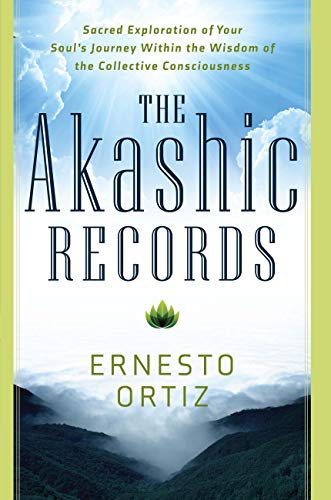The Akashic Records: Sacred Exploration of Your Soul’s Journey Within the Wisdom of the Collective Consciousness
By Ernesto Ortiz
Published by New Page Books, 2015
This ambitious little volume claims to allow us to “access the sum of all knowledge, past and present.” For readers acquainted with the concept of the akashic records, we understand that they represent the collective and individual history of all mankind and reside in the spiritual realm.
Motivated by a desire to help others find a higher consciousness and specifically addressed to “light workers,” Ortiz discusses the health of the planet, both environmentally and spiritually. And while his efforts and motives are to be applauded, there are some issues with the content of the work, and the presentation.
Ortiz makes use of many metaphors to get his points across, but a few too many are mixed, or miss the mark. He shares some interesting history and his diagrams are informative. He attempts to explain a “whole cloth” view of shamanism, spirituality, New Age thinking, and the collective consciousness.
The good news is, if you are new to this kind of thinking, you will probably learn a lot.
The bad news is, if you’re new to this kind of thinking, you probably won’t be inclined to read this book. Much basic information is presented that would benefit the novice, but much of the language and topic is too advanced for the beginner in the spiritual quest.
This is clearly not a beginner’s book. Ortiz tires to make it so, by only succeeds in delaying his point, and possibly alienating the truly interested, but spiritually experienced reader. He spends too much time on thing better learned elsewhere and written by more engaging authors.
I learned little new regarding the akashic records and how to access them and if I were a beginner, I would still feel lost as to how to actually use the techniques of reading them. He often gives instructions out of order, telling us how to describe the information obtained from the records, for instance, long before telling us how to access them.
Like many spiritual teachers, he often implies that we must completely release any compulsion, addiction, fear or doubt for the techniques to work. I am of the opinion that one must pursue spiritual goals in the face of compulsion, addiction, fear or doubt. If you wait until you are “free” of them, you will never begin the journey. Ortiz implies that if we acknowledge our woundedness that we are being self-pitying, and will not be able to learn how to access such holy information. This is an error which afflicts many a powerful spiritual teacher—insisting the student be “worthy” before receiving healing. It is a subconscious habit that priesthoods have practiced for millennia, allowing their own egos and need for power to make judgments on others.
Ortiz and I part way on other issues. I am skeptical of his claim, made on page 67, that “spiritual research indicates that 96 percent of addictions are due to ghosts, entities, demons, devils, negative energies or departed ancestors.” While spiritual influences may explain some negative behaviors, many more are caused by being the recipient of actual abuse or neglect, by biochemical imbalances in the brain, or by faulty teachings. Such a statement, unsupported by research sources, undermines the author’s credibility and the readers’ credulity.
He states on page 71 that “The ego is the source of all self-grasping, self-cherishing, and self-absorption.” But self-cherishing and self-care and self-loving is often our path to true healing. If we have no love for ourselves, how can we have enough love for others? Self-cherishing is the reason we put on the oxygen mask in the airplane before we place one on others who need our care. If we can’t breathe, we can’t help others to breathe.
For women, especially, this notion that self-loving is wrong is another problem with our patriarchal culture in general, and its long-term influence on spiritual thinking. Women are socialized to be self-effacing, not to brag, not to be proud (except of our appearance), and to do, do, do, for others before ourselves. We cannot empower others if we are not empowered ourselves.
He also insists that the prayers he shares in the book must be spoken word for word. No room for interpretation or for a heartfelt prayer. This is a kind of legalism that creates rigidity within spiritual traditions, and certainly does not allow for differences in the many languages of mankind.
The chapter on “Protection” and “Grounding” are clear, helpful and informative; Ortiz shines in this department.
Chapter 17, “Akashic Records Consultation” contains some very specific guidelines that seem arbitrary to me. His insistence that the “sacred prayer” be handled as gingerly as the American flag or a loaded gun seems a bit much. He warns the reader to never memorize the prayer, but to only read it aloud (apparently, this teaching then is only for the literate and the sighted). He also implies that the method for using it and the prayer itself must be kept separate lest it fall into unguided hands. Ortiz writes, “the Akashic records are not for everyone” and “you’ll want to protect it at all times” as if anything as powerful and divine needed protecting, and only the elite (i.e. those who read this book) were entitled to understand it.
The insistence that this prayer be read aloud word-for-word neglects the fact that our spiritual power is based on intention. It is always the true intention that creates pure connection to the Divine. To simply recite something aloud, as directed by someone else (there is that controlling priesthood idea again), but with the intention to do harm or to acquire power over others is completely neglected. To frame a prayer within your own personal understanding but with clear intentions will get you there just as quickly, if not more so, as I have learned in my own spiritual journey. If your intention is good and powerful, it matters not what syntax you use or which language you speak in, or if you recite something verbatim.
Another reason this is a quite discomfiting notion is that he claims to have translated it directly from the Mayan hieroglyphs! If what he says is true, then it should only be recited in ancient Mayan, for in translating it to English, there must be some loss of meaning or changing of wording.
He admonishes strongly that no recreational drugs or excessive drinking be indulged in before accessing this spiritual storehouse of knowledge. (Prescription drugs are allowed, apparently because Spirit obeys doctors, too). He completely ignores the long-standing spiritual traditions of connecting with Spirit through the use of consciousness-altering drugs or alcohol—which has a respected place in many traditions.
Chapter 19, like too many New Age books, offers an unnecessarily lengthy explanation of the chakras, although there is a helpful three-dimensional diagram of the chakras and their energy flow on page 150.
Overall, many may find this volume useful, but I suggest one read it with a slightly skeptical eye. Take in the information and process it for yourself—as you must do with all spiritual guidance. Any author is simply sharing what they have learned and what has worked for them. The reader seeking enlightenment ultimately has to find their own path to get there and while we can learn from others, we each have a unique way to achieve our greatest spiritual awareness.


